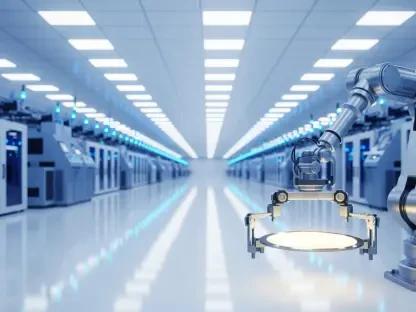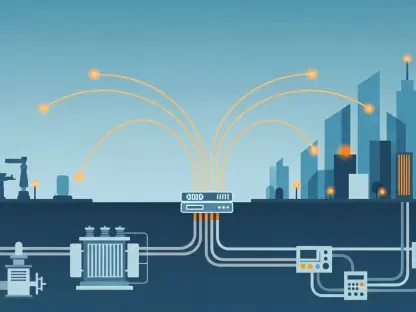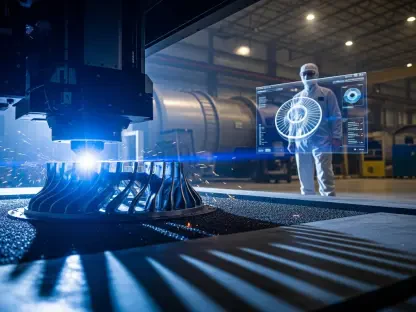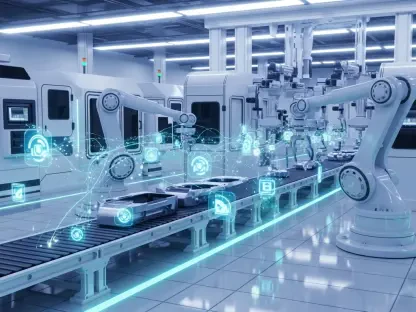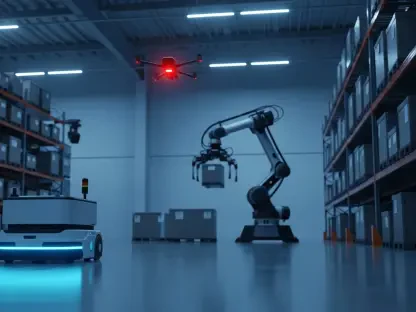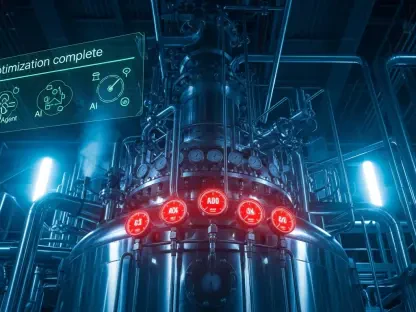In an era where manufacturing is being redefined by digital innovation, two German industrial giants, Siemens and TRUMPF, have joined forces to push the boundaries of what smart factories can achieve. Their groundbreaking partnership addresses one of the most persistent challenges in the industry: the disconnect between Information Technology (IT) and Operational Technology (OT). By combining Siemens’ advanced digital software with TRUMPF’s expertise in high-quality machinery, this collaboration is crafting production environments that are not only interconnected but also primed for artificial intelligence (AI). The vision is clear—factories that can think, adapt, and optimize in real time, setting a new benchmark for efficiency and flexibility. This alliance represents a pivotal moment, promising to reshape industrial processes by breaking down long-standing barriers and equipping manufacturers with tools to thrive in a rapidly evolving landscape.
The Core of the Collaboration
Bridging IT and OT Systems
The partnership between Siemens and TRUMPF focuses on a critical pain point in manufacturing: the historical separation between IT, which handles enterprise-level data and software, and OT, which governs shop floor hardware and control systems. For decades, these domains have operated in isolation, resulting in fragmented data, delayed responses, and missed opportunities for optimization. By developing open interfaces and interoperable solutions, this collaboration enables a seamless flow of information from machines to management systems. This connectivity allows for real-time decision-making, where a glitch on the production line can be instantly flagged and addressed without manual intervention. Such integration is a game-changer, ensuring that every layer of a factory operates in sync, reducing inefficiencies and paving the way for smarter operations across diverse industrial settings.
Beyond just linking systems, the focus on IT and OT convergence is about creating a responsive manufacturing ecosystem. Imagine a scenario where data from a laser cutter directly informs inventory software, preventing overproduction or shortages before they occur. Siemens and TRUMPF are crafting solutions that empower factories to act proactively rather than reactively, enhancing agility in a market where speed is paramount. This approach tackles not only current inefficiencies but also sets a foundation for integrating more complex technologies down the line. The result is a dynamic environment where every piece of equipment communicates effectively with enterprise tools, ensuring that decisions are data-driven and immediate, ultimately boosting productivity and reducing operational bottlenecks in modern plants.
Building AI-Ready Factories
A cornerstone of this collaboration is the preparation of factories for AI-driven transformation, moving beyond mere connectivity to a future where machines learn and adapt autonomously. Siemens and TRUMPF are building a robust digital infrastructure that supports AI applications like adaptive motion control, enabling equipment to adjust to varying production demands on the fly. This isn’t just about automating tasks; it’s about creating systems that can predict issues, such as wear and tear on a robotic arm, and optimize workflows without human input. Such capabilities mark a significant leap toward intelligent manufacturing, where downtime is minimized, and output is maximized through predictive and prescriptive analytics embedded in the factory’s core.
This push for AI readiness also reflects a broader vision of self-optimizing production lines that evolve with market needs. By embedding a digital backbone into factory systems, the partnership ensures that data collected from every machine can be harnessed for AI algorithms to refine processes continuously. For instance, AI could analyze historical production data to forecast demand spikes and adjust schedules accordingly, ensuring resources are allocated efficiently. Siemens and TRUMPF are not just solving today’s challenges but anticipating tomorrow’s demands, positioning manufacturers to leverage cutting-edge technology. This forward-thinking strategy promises to redefine operational excellence, making factories not just smart, but truly intelligent in their ability to adapt and innovate over time.
Technological Innovations Driving Change
Siemens’ Digital Expertise
Siemens plays a pivotal role in this alliance by bringing its Xcelerator portfolio to the table, a comprehensive suite of Industry 4.0 solutions designed to accelerate digital transformation. This collection of software and automation tools creates a connected ecosystem where data flows effortlessly across production layers, from shop floor sensors to executive dashboards. The emphasis is on real-time analytics, enabling manufacturers to monitor performance metrics instantly and make informed adjustments. Siemens’ contribution ensures that the IT infrastructure is robust enough to handle the demands of modern factories, providing the digital scaffolding necessary to integrate complex technologies and drive efficiency at every level of operation.
Additionally, Siemens’ tools lay crucial groundwork for embedding AI into manufacturing processes, transforming raw data into actionable insights. With the Xcelerator portfolio, factories can harness cloud-based analytics to optimize energy usage or streamline supply chains, all while maintaining seamless communication between disparate systems. This digital prowess is vital for scaling operations, allowing manufacturers to expand without facing integration hurdles. By focusing on connectivity and analytics, Siemens empowers the partnership to deliver solutions that are not only effective today but also adaptable to future innovations, ensuring that manufacturers remain agile in a competitive and tech-driven industrial landscape.
TRUMPF’s Hardware Mastery
TRUMPF, a leader in sheet metal machinery, complements Siemens’ digital focus with its deep expertise in factory hardware, enhancing equipment with open IT/OT interfaces for smarter operations. Renowned for precision tools like laser cutters and welding systems, TRUMPF is redefining how physical assets integrate with digital networks. Through this collaboration, their machines are being equipped to communicate directly with enterprise systems, enabling smoother data exchange and real-time monitoring. This integration enhances capabilities in areas like robotic control, where equipment can adjust dynamically to production needs, ensuring precision and reducing waste in high-stakes manufacturing environments.
Moreover, TRUMPF’s innovations extend to specialized applications such as AI-driven part recognition, which allows machines to identify and process components with minimal human oversight. This level of automation not only boosts efficiency but also cuts down on errors, delivering consistent quality in output. By aligning hardware with open standards, TRUMPF ensures that its solutions are compatible with a wide range of digital platforms, making adoption easier for manufacturers. The synergy between TRUMPF’s hardware advancements and digital connectivity marks a significant step forward, creating factory floors where physical and digital elements work in perfect harmony to elevate performance.
Standardizing for Scalability
A key innovation from this partnership is the development of standardized, open interfaces that eliminate compatibility issues between diverse systems in manufacturing. Historically, proprietary setups have hindered integration, forcing costly custom solutions or limiting tech adoption. Siemens and TRUMPF are addressing this by creating protocols that allow shop floor equipment to connect effortlessly with enterprise software, regardless of the vendor. This standardization is crucial for scalability, enabling manufacturers to incorporate new tools or AI applications without overhauling existing infrastructure, thus saving time and resources while maintaining operational continuity.
Furthermore, the emphasis on open systems fosters industry-wide collaboration by breaking down barriers created by closed ecosystems. Manufacturers can now mix and match technologies from various providers, driving innovation and reducing dependency on single suppliers. This approach not only benefits individual companies but also strengthens the broader manufacturing sector by encouraging a shared ecosystem of progress. Siemens and TRUMPF are setting a precedent with these interoperable solutions, ensuring that factories can scale efficiently and remain adaptable to emerging trends, ultimately future-proofing operations in a fast-evolving technological landscape.
Industry Trends and Broader Impact
Aligning with Industry 4.0
The Siemens and TRUMPF partnership mirrors the global momentum toward Industry 4.0, a paradigm that integrates cyber-physical systems, the Internet of Things (IoT), big data, and AI into industrial processes. This fourth industrial revolution is reshaping how factories operate, emphasizing connectivity and intelligence over isolated automation. Their collaborative efforts to merge IT and OT systems align directly with this trend, ensuring that manufacturers can achieve greater visibility and control over their operations. Industry consensus holds that digital transformation is no longer a choice but a necessity for competitiveness, and this alliance is a tangible step toward realizing that vision on a wide scale.
Additionally, the focus on smart factories underscores the urgency for manufacturers to adopt technologies that keep pace with global demands. By embedding IoT for real-time tracking and AI for predictive insights, Siemens and TRUMPF are helping companies transition to fully integrated environments where every asset contributes to a unified data stream. This alignment with Industry 4.0 principles positions their solutions as critical tools for staying relevant in a market driven by innovation. The partnership serves as a model for how targeted collaborations can accelerate the adoption of transformative technologies, influencing standards and practices across the industrial sector worldwide.
Software as a Key Differentiator
Increasingly, software is emerging as a vital component in manufacturing, shifting from a supporting role to a primary driver of value alongside hardware. Siemens and TRUMPF recognize this trend, prioritizing seamless integration of digital tools with physical systems to unlock new levels of performance. Software now enables capabilities like remote monitoring and process optimization, which were once unimaginable without significant manual effort. This shift highlights a broader industry realization that hybrid solutions—where software and hardware operate as one—are essential for achieving flexibility in production and responding to dynamic market conditions effectively.
Moreover, the growing importance of software is evident in how it enhances decision-making through actionable insights derived from vast data sets. Factories equipped with advanced software can simulate production scenarios or predict equipment failures, ensuring smoother operations and less downtime. Siemens and TRUMPF’s commitment to this hybrid approach sets their solutions apart, offering manufacturers a competitive edge through enhanced adaptability. As software continues to redefine industrial capabilities, their partnership exemplifies how digital innovation can transform traditional manufacturing into an agile, data-driven powerhouse.
Benefits for Manufacturers
Operational and Financial Gains
The integration of IT and OT systems through Siemens and TRUMPF’s collaboration delivers substantial operational improvements for manufacturers, streamlining processes in ways previously unattainable. By enabling real-time data exchange between shop floor machines and enterprise software, factories can minimize downtime through immediate issue detection and resolution. For example, live data can align production schedules with demand fluctuations, preventing overstock or delays. This heightened efficiency translates into optimized resource use, ensuring that energy, materials, and labor are deployed with precision, ultimately enhancing overall productivity in highly competitive markets.
Financially, the partnership offers significant cost savings by reducing the need for extensive engineering efforts during system upgrades or maintenance. Standardized interfaces and modular designs mean that manufacturers can implement new technologies without expensive custom integrations, lowering the barrier to innovation. These savings allow companies to redirect funds toward research or expansion, fostering growth. The combined effect of operational streamlining and reduced expenses positions manufacturers to achieve better profitability, making this collaboration a catalyst for sustainable economic success in the industrial sector.
Future-Proofing and Competitive Edge
Scalability is at the heart of Siemens and TRUMPF’s solutions, ensuring that manufacturers can adapt to rapid technological advancements without facing prohibitive costs or disruptions. Their modular system architecture allows for the easy addition of new machines, software, or AI tools, keeping factories relevant as industry standards evolve. This adaptability is critical in an era where technologies like IoT and AI are progressing swiftly, demanding flexible infrastructure to support continuous improvement. By future-proofing operations, the partnership helps manufacturers stay ahead of the curve, ready to embrace innovations that enhance their capabilities over the long term.
Equally important is the competitive advantage gained through faster time-to-market and improved productivity. With streamlined processes and responsive systems, manufacturers can bring products to consumers more quickly, meeting market demands with agility. Enhanced output quality and efficiency further solidify their standing against rivals, as customers benefit from reliable, high-performing solutions. Siemens and TRUMPF have crafted a framework that not only addresses immediate needs but also empowers manufacturers to lead in their industries, setting a foundation for enduring success in a tech-driven global economy.
Reflecting on a Transformative Partnership
Looking back, the alliance between Siemens and TRUMPF stands as a landmark effort in redefining smart factories through the integration of IT and OT systems. Their commitment to open standards and AI-ready infrastructure tackles inefficiencies that once plagued manufacturing, delivering measurable gains in agility and cost-effectiveness. This collaboration demonstrates how strategic partnerships can address complex industrial challenges, leaving a lasting impact on how factories operate. Moving forward, the industry can build on this foundation by fostering similar cooperative models, prioritizing interoperability, and investing in digital frameworks that support emerging technologies. The path they have charted offers a clear direction—embracing innovation through unity holds the key to unlocking the full potential of modern manufacturing.


